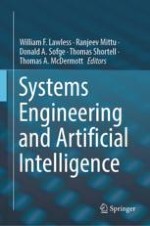2021 | OriginalPaper | Chapter
7. Human-Autonomy Teaming for the Tactical Edge: The Importance of Humans in Artificial Intelligence Research and Development
Authors : Kristin E. Schaefer, Brandon Perelman, Joe Rexwinkle, Jonroy Canady, Catherine Neubauer, Nicholas Waytowich, Gabriella Larkin, Katherine Cox, Michael Geuss, Gregory Gremillion, Jason S. Metcalfe, Arwen DeCostanza, Amar Marathe
Published in: Systems Engineering and Artificial Intelligence
Publisher: Springer International Publishing
Activate our intelligent search to find suitable subject content or patents.
Select sections of text to find matching patents with Artificial Intelligence. powered by
Select sections of text to find additional relevant content using AI-assisted search. powered by
